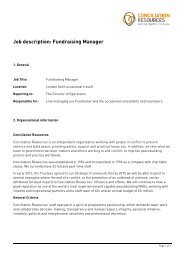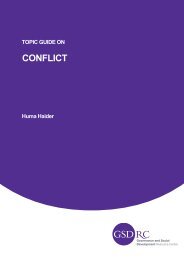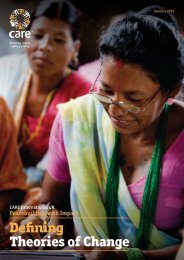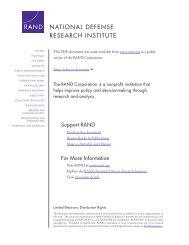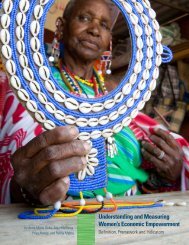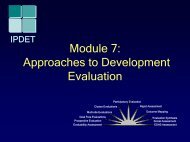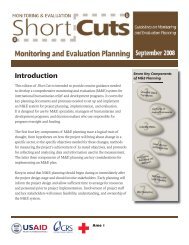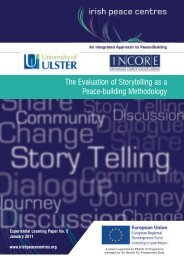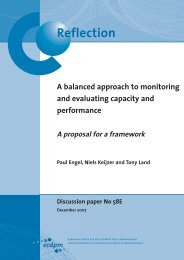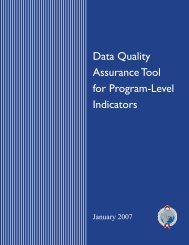Measuring Achievements of Private Sector Development in ... - DCED
Measuring Achievements of Private Sector Development in ... - DCED
Measuring Achievements of Private Sector Development in ... - DCED
Create successful ePaper yourself
Turn your PDF publications into a flip-book with our unique Google optimized e-Paper software.
<strong>Measur<strong>in</strong>g</strong> <strong>Achievements</strong> <strong>of</strong> <strong>Private</strong> <strong>Sector</strong> <strong>Development</strong> <strong>in</strong> Conflict-Affected Environments<br />
<strong>of</strong> reasons. There may be few people who understand market development <strong>in</strong> the local area, the<br />
market environment may have been rapidly<br />
chang<strong>in</strong>g as a result <strong>of</strong> the conflict, and it may be<br />
hard to gather new <strong>in</strong>formation due to a lack <strong>of</strong><br />
secondary <strong>in</strong>formation or formal <strong>in</strong>stitutions.<br />
Complexity. CAEs have multiple actors and<br />
numerous causes <strong>of</strong> conflict. This can result <strong>in</strong> a<br />
complex <strong>in</strong>teraction between the project and the<br />
context. Expected results have multiple causes, and<br />
project activities can have multiple effects – not all<br />
<strong>of</strong> which are l<strong>in</strong>ear or predictable. However, the<br />
results cha<strong>in</strong> design must balance complexity and<br />
usability. If it is overly simple, it will not capture the<br />
project logic. If it is overly complex, such as <strong>in</strong> the<br />
Figure 1: Mapp<strong>in</strong>g Complex Conflicts<br />
This excerpt from a diagram <strong>of</strong> the Afghan context<br />
shows how complex any attempt to fully represent a<br />
conflict can be.<br />
adjacent figure, 5 it is difficult to read and monitor aga<strong>in</strong>st. While this is true <strong>in</strong> every context, the<br />
presence <strong>of</strong> conflict <strong>in</strong>troduces additional complications that make this balanc<strong>in</strong>g act particularly<br />
challeng<strong>in</strong>g.<br />
Fast pace <strong>of</strong> change. Rapid change can render a results cha<strong>in</strong> out <strong>of</strong> date. For example,<br />
<strong>in</strong>tensification <strong>of</strong> a conflict may make market actors unwill<strong>in</strong>g to cont<strong>in</strong>ue participat<strong>in</strong>g <strong>in</strong> an<br />
<strong>in</strong>tervention and thus <strong>in</strong>validate that <strong>in</strong>tervention’s results cha<strong>in</strong>.<br />
Knowledge gaps about the relationship between PSD and peacebuild<strong>in</strong>g. While there are theories<br />
about the relationship between PSD <strong>in</strong>terventions and peacebuild<strong>in</strong>g, there is limited evidence on<br />
the detailed causal relationships, or the contexts <strong>in</strong> which those relationships hold. 6 For example, a<br />
recent systematic review by the Overseas <strong>Development</strong> Institute found that, out <strong>of</strong> 9,558 articles<br />
reviewed, only one provided any evidence regard<strong>in</strong>g whether or not employment creation<br />
promoted stability. 7<br />
1.1 Incorporat<strong>in</strong>g conflict <strong>in</strong>to results cha<strong>in</strong>s (Control Po<strong>in</strong>t 1.1-1.2)<br />
Develop<strong>in</strong>g and ma<strong>in</strong>ta<strong>in</strong><strong>in</strong>g results cha<strong>in</strong>s requires staff to cont<strong>in</strong>ually exam<strong>in</strong>e their own assumptions<br />
and validate the l<strong>in</strong>kages between levels <strong>of</strong> their results cha<strong>in</strong>s. This is important <strong>in</strong> a CAE, where l<strong>in</strong>ks<br />
that are valid <strong>in</strong> a stable context may not hold. For example:<br />
Assumption: adequate trust exists for economic relationships to be built. Economic engagement<br />
between members <strong>of</strong> different groups requires trust. The United States Agency for International<br />
<strong>Development</strong> (USAID) found that ‘[b]ecause conflict breaks down trust between people, some forms<br />
<strong>of</strong> support and collaboration will only be possible when basic elements <strong>of</strong> trust are restored.’ 8<br />
5 Diagram cited <strong>in</strong> Banyan Global, Enterprise <strong>Development</strong>, Poverty and Conflict, 2010.<br />
6 Mercy Corps, Evaluation and Assessment <strong>of</strong> Poverty and Conflict Interventions. Conflict & Economics: Lessons<br />
Learned on <strong>Measur<strong>in</strong>g</strong> Impact, 2011, 6.<br />
7 Holmes et al, What is the evidence on the impact <strong>of</strong> employment creation on stability and poverty reduction <strong>in</strong><br />
fragile states: A systematic review, 2013, v.<br />
8 USAID, Conflict and Livelihoods, 2005, 11.<br />
Practical Guidel<strong>in</strong>es for Implement<strong>in</strong>g the <strong>DCED</strong> Standard. Version 2, July 2013<br />
7



